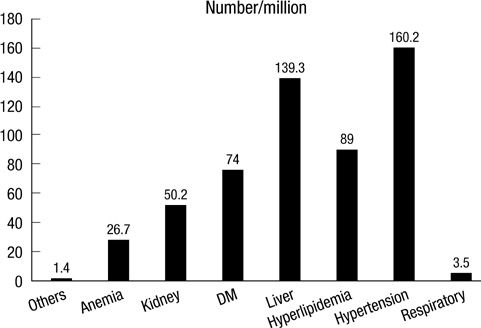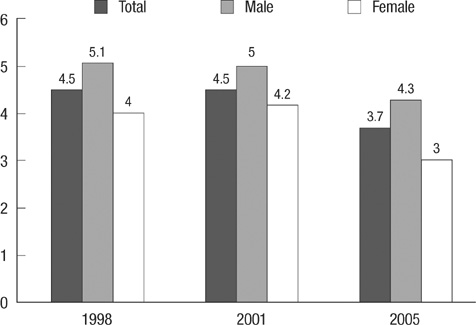J Korean Med Sci.
2010 Dec;25(Suppl):S36-S40. 10.3346/jkms.2010.25.S.S36.
Occupational Hepatic Disorders in Korea
- Affiliations
-
- 1Department of Preventive Medicine and Industrial Medical Center, The Catholic University of Korea, College of Medicine, Seoul, Korea. cyclor@catholic.ac.kr
- 2Occupational Safety and Health Research Institute, KOSHA, Incheon, Korea.
- KMID: 1714065
- DOI: http://doi.org/10.3346/jkms.2010.25.S.S36
Abstract
- Occupational hepatic disorders are classified into toxic hepatitis, viral hepatitis, and chemical-induced malignancy in Korea. Toxic hepatitis cases were reported in workers who were exposed to dimethylformamide, dimethylacetamide, or trichloroethylene. Pre-placement medical examination and regular follow-up are necessary to prevent the development of toxic hepatitis. Viral hepatitis was chiefly reported among health care workers such as doctors, nurses and clinical pathology technicians who could easily be exposed to blood. Preventive measures for these groups therefore include vaccination and serum monitoring programs. Hepatic angiosarcoma caused by vinyl chloride monomer (VCM) exposure is a very well known occupational disease and it has not been officially reported in Korea yet. Some cases of hepatocellular carcinoma were legally approved for compensation as an occupational disease largely by overwork and stress, but not supported by enough scientific evidence. Effort to find the evidence of its causal relationship is needed.
Keyword
MeSH Terms
-
Adult
Drug-Induced Liver Injury/epidemiology
Female
Health Personnel
Hepatitis, Viral, Human/epidemiology/prevention & control
Humans
Liver Diseases/*epidemiology/prevention & control
Liver Neoplasms/chemically induced/epidemiology
Male
Middle Aged
Occupational Diseases/*chemically induced/*epidemiology/prevention & control
Occupational Exposure/adverse effects
Republic of Korea/epidemiology
Young Adult
Figure
Cited by 1 articles
-
The Health Status and Management of Migrant Workers in Cheonan: A Comparison Study With Korean Citizens
Sungyeon Kim, Dong Jun Lee, Seung Hyeon Kim, Min Su Byun, Young Sun Yun, Nam Kyu Lim
J Korean Med Sci. 2023;38(46):e398. doi: 10.3346/jkms.2023.38.e398.
Reference
-
1. Ministry for Health and Welfare. Results of Korean National Health & Nutrition Examination Survey III. accessed on 15 Oct 2009. Available at http://knhanes.cdc.go.kr/.2. Statistics on occupational injuries and diseases 2008. Ministry of Employment and Labor. accessed on 15 Oct 2009. Available at http://www.molab.go.kr/policyinfo/safety/view.jspcate=10&sec=1&bbs_cd=105.3. Johnson D, Groopman JD. Rom WN, editor. Toxic Liver Disorders. Environmental and Occupational Medicine. 2007. Philadelphia: Lippincott;789–799.4. Ahn YS, Kang SK, Kwon HG, Chung HK. Analysis of occupational disease approved by Korea Labor Welfare Corporation in 1999. Korean J Occup Environ Med. 2001. 13:449–460.5. Ahn YS, Kang SK, Kim KJ. Analysis of occupational diseases compensated with the industrial accident compensation insurance from 2001 to 2003. Korean J Occup Environ Med. 2004. 16:139–154.6. Ha BG, Kim JS, Yu JY, Woo KH, Ham JO, Yoon SY, Jang YS, Jung SJ. A case of toxic hepatitis in a worker exposed to a cleansing agent mainly composed of methylene chloride. Korean J Occup Environ Med. 2004. 16:210–219.7. Benichou C, Danan G, Flahault A. Causality assessment of adverse reactions to drugs-II. An original model for validation of drug causality assessment methods: case reports with positive rechallenge. J Clin Epidemiol. 1993. 46:1331–1336.8. Danan G, Benichou C. Causality assessment of adverse reactions to drugs--I. A novel method based on the conclusions of international consensus meetings: application to drug-induced liver injuries. J Clin Epidemiol. 1993. 46:1323–1330.9. Maria VA, Victorino RM. Development and validation for a clinical scale for the diagnosis of drug-induced hepatitis. Hepatology. 1997. 26:664–669.10. Kang SK. Occupational toxic hepatitis. Occup Health. 2000. 143:5–12.11. American Conference of Governmental Industrial Hygienists. Dimethylformamide. 2005 TLVs and BEIs: based on the documentation of the threshold limit values for chemical substances and physical agents and biological exposure indices. 2005. Cincinnati, OH: American Conference of Governmental Industrial Hygienists;1–3.12. Kim SA, Kim JS, Jeon HR, Jung SJ, Kim SW, Lee CY, Ham JO, Yoo JY, Choi TS, Goo HB, Cho MH, Woo KH. Surveillance of work-related diseases in Kumi. Korean J Occup Environ Med. 2003. 15:95–110.13. Jang YS, Yoon SY, Jo SY, Choi TS, Yoo JY, Woo KH, Ha BG, Jung SJ, Chun BY, Kim JS. Incidence of dimethylacetamide-induced toxic liver injury among workers in a synthetic fiber manufacturing company. Korean J Occup Environ Med. 2006. 18:246–254.14. American Conference of Governmental Industrial Hygienists. Trichloroethylene. 2005 TLVs and BEIs: based on the documentation of the threshold limit values for chemical substances and physical agents and biological exposure indices. 2005. Cincinnati, OH: American Conference of Governmental Industrial Hygienists;1–6.15. Klockars M. Riihimaki V, Ulfvarson U, editors. Solvents and the liver. Safety and health aspects of organic solvents. 1986. New York: Alan R. Liss;139–154.16. Hong DP, Kim JS, Kim SH, Kim JM, Lee ES. A case of toxic erythema, toxic hepatitis and exfoliative dermatitis due to trichloroethylene. Korean J Dermatol. 1985. 23:785–789.17. Chae HB, Kim JA, Lee KS, Park SM, Yoon TY, Yoon SJ. A case of hepatitis after occupational exposure of trichloroethylene. Korean J Hepatol. 1999. 5:59–64.18. Kang S, Chae H, Lee N. Report of an epidemiological survey in a Korean overseas affiliated company in the Philippines. 1999. Incheon: Occupational Safety and Health Institute, Korea Occupational Safety and Health Agency;1–9.19. Chae HJ, Lee SK, Lee KJ, Kim JY, Lee SC, Shin DH, Moon JD. Exfoliative dermatitis and toxic hepatitis associated with occupational exposure to trichloroethylene. Korean J Occup Environ Med. 2003. 15:111–117.20. Lee SW, Kim EA, Kim DS, Koh DH, Kang SK, Kim BK, Kim MK. Exposure level of trichloroethylene in Stevens-Johnson syndrome due to occupational exposure: 3 case reports and a review of other cases. Korean J Occup Environ Med. 2008. 20:132–146.21. Phoon WH, Chan MO, Rajan VS, Tan KJ, Thirumoorthy T, Goh CL. Stevens-Johnson syndrome associated with occupational exposure to trichloroethylene. Contact Dermatitis. 1984. 10:270–276.22. Lim HS, Ahn YS. Occupational diseases among health care workers approved by Korea Labor Welfare Corporation. Korean J Occup Environ Med. 2003. 15:196–204.



